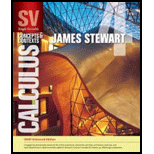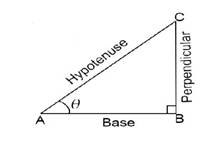
To calculate: The length of the shortest ladder that will reach from the ground over the fence to the well of the building. If fence 8 ft tell runs parallel to a tall building at a distance of 4 ft from the building.
Answer to Problem 26E
The length of the shortest ladder that will reach from the ground over the fence to the well of the building 16.65 ft
Explanation of Solution
Given information:
A fence 8 ft tell runs parallel to a tall building at a distance of 4 ft from the building.
.
Formula used:
Pythagorean Theorem: The sum of the squares on the legs of the right angled triangle is equal to the square on the side opposite to the right angle triangle. That is:

(H)2=(P)2+(B)2
Similarity property: If two triangles say △ABC and △PQR are similar. Then
Corresponding sides of the triangles are in proportional, i.e

ABPQ=ACPR=ABQR
And
Let f be a differentiable function defined on an interval I and let a∈I .
Then
- x=a is a point of local maximum value of f, if
- f′(a)=0 and
- f′(x) changes sign from positive to negative as x increases through a , i.e. if f′(x)>0 at every point sufficiently close to and to the left of a , and f′(x)<0 at every point sufficiently close to and to the right of a , then a is a point of local maxima
- x=a is a point of local maximum value of f, if
- f′(a)=0 and
- f′(x) changes sign from negative to positive as x increases through a , i.e. if f′(x)<0 at every point sufficiently close to and to the left of a , and at f′(x)>0 every point sufficiently close to and to the right of a , then a is a point of local minima.
- f′(a)=0 and If f′(x) does not change sign as x increases through a , then a is neither a point of local maxima nor a point of local minima.
- If f″(a)>0 then f has a local minimum at x=a
- If f″(a)<0 then f has a local maximum at x=a
Calculation:
As per the given problem
Draw the diagram of a fence 8 ft tell runs parallel to a tall building at a distance of 4 ft from the building

Recall that, If two triangles say △ABC and △PQR are similar. Then
Corresponding sides of the triangles are in proportional,
Here, △ADE and △ABC are similar,
Therefore,
h8=x+4x⇒h=8(x+4)x
Recall that, Pythagorean Theorem: The sum of the squares on the legs of the right angled triangle is equal to the square on the side opposite to the right angle triangle.
In △ABC
l2=h2+(x+4)2
Substitute h=8(x+4)x ,and simplified
l2=h2+(x+4)2l2(x) ={8(x+4)x}2+(x+4)2l2(x) ={8+32x}2+(x+4)2 ......(1)
Recall that,
Let f be a differentiable function defined on an interval I and let a∈I .
Then
- x=a is a point of local maximum value of f, if
- f′(a)=0 and
- f′(x) changes sign from positive to negative as x increases through a , i.e. if f′(x)>0 at every point sufficiently close to and to the left of a , and f′(x)<0 at every point sufficiently close to and to the right of a , then a is a point of local maxima
- x=a is a point of local maximum value of f, if
- f′(a)=0 and
- f′(x) changes sign from negative to positive as x increases through a , i.e. if f′(x)<0 at every point sufficiently close to and to the left of a , and at every point sufficiently close to and to the right of a , then a is a point of local minima.
- f′(a)=0 and If f′(x) does not change sign as x increases through a , then a is neither a point of local maxima nor a point of local minima.
- If f″(a)>0 then f has a local minimum at x=a
- If f″(a)<0 then f has a local maximum at x=a
Differentiate on both sides,
ddxl2(x) =ddx[(8+32x)2+(x+4)2] =2(8+32x)×−32x2+2(x+4)×1 =−64(32+8xx3)+2(x+4) ......(2)
Solve for ddxl2(x) =0 , and simplified
−64(32+8xx3)+2(x+4)=0⇒64×8(4+xx3)=2(x+4)⇒ 1x3=1256⇒ x3=256
Take cube root on both sides,
x=3√256⇒ x≈6.35
Differentiate equation (2) with respect to l
d2dx2l2(x) =−64ddx(32+8xx3)+2ddx(x+4) =−64(−96x4−16x2)+2 =64(96x4+16x2)+2
Therefore,
d2dx2l2(x) =64(96x4+16x2)+2≥0
For x≈6.35 the length of ladder is minimum
Substitute x≈6.35 in equation (1) and simplified
l2(6.35) ={8+326.35}2+(6.35+4)2 ≈169.78+107.12 ≈276.90
Take square root on both sides,
l(6.35) ≈16.65
Conclusion:
Thus the length of the shortest ladder that will reach from the ground over the fence to the well of the building 16.65 ft
Chapter 4 Solutions
Single Variable Calculus: Concepts and Contexts, Enhanced Edition
- 1. A bicyclist is riding their bike along the Chicago Lakefront Trail. The velocity (in feet per second) of the bicyclist is recorded below. Use (a) Simpson's Rule, and (b) the Trapezoidal Rule to estimate the total distance the bicyclist traveled during the 8-second period. t 0 2 4 6 8 V 10 15 12 10 16 2. Find the midpoint rule approximation for (a) n = 4 +5 x²dx using n subintervals. 1° 2 (b) n = 8 36 32 28 36 32 28 24 24 20 20 16 16 12 8- 4 1 2 3 4 5 6 12 8 4 1 2 3 4 5 6arrow_forward= 5 37 A 4 8 0.5 06 9arrow_forwardConsider the following system of equations, Ax=b : x+2y+3z - w = 2 2x4z2w = 3 -x+6y+17z7w = 0 -9x-2y+13z7w = -14 a. Find the solution to the system. Write it as a parametric equation. You can use a computer to do the row reduction. b. What is a geometric description of the solution? Explain how you know. c. Write the solution in vector form? d. What is the solution to the homogeneous system, Ax=0?arrow_forward
- 2. Find a matrix A with the following qualities a. A is 3 x 3. b. The matrix A is not lower triangular and is not upper triangular. c. At least one value in each row is not a 1, 2,-1, -2, or 0 d. A is invertible.arrow_forwardFind the exact area inside r=2sin(2\theta ) and outside r=\sqrt(3)arrow_forwardA 20 foot ladder rests on level ground; its head (top) is against a vertical wall. The bottom of the ladder begins by being 12 feet from the wall but begins moving away at the rate of 0.1 feet per second. At what rate is the top of the ladder slipping down the wall? You may use a calculator.arrow_forward
- Explain the key points and reasons for the establishment of 12.3.2(integral Test)arrow_forwardUse 12.4.2 to determine whether the infinite series on the right side of equation 12.6.5, 12.6.6 and 12.6.7 converges for every real number x.arrow_forwarduse Cauchy Mean-Value Theorem to derive Corollary 12.6.2, and then derive 12.6.3arrow_forward
 Calculus: Early TranscendentalsCalculusISBN:9781285741550Author:James StewartPublisher:Cengage Learning
Calculus: Early TranscendentalsCalculusISBN:9781285741550Author:James StewartPublisher:Cengage Learning Thomas' Calculus (14th Edition)CalculusISBN:9780134438986Author:Joel R. Hass, Christopher E. Heil, Maurice D. WeirPublisher:PEARSON
Thomas' Calculus (14th Edition)CalculusISBN:9780134438986Author:Joel R. Hass, Christopher E. Heil, Maurice D. WeirPublisher:PEARSON Calculus: Early Transcendentals (3rd Edition)CalculusISBN:9780134763644Author:William L. Briggs, Lyle Cochran, Bernard Gillett, Eric SchulzPublisher:PEARSON
Calculus: Early Transcendentals (3rd Edition)CalculusISBN:9780134763644Author:William L. Briggs, Lyle Cochran, Bernard Gillett, Eric SchulzPublisher:PEARSON Calculus: Early TranscendentalsCalculusISBN:9781319050740Author:Jon Rogawski, Colin Adams, Robert FranzosaPublisher:W. H. Freeman
Calculus: Early TranscendentalsCalculusISBN:9781319050740Author:Jon Rogawski, Colin Adams, Robert FranzosaPublisher:W. H. Freeman
 Calculus: Early Transcendental FunctionsCalculusISBN:9781337552516Author:Ron Larson, Bruce H. EdwardsPublisher:Cengage Learning
Calculus: Early Transcendental FunctionsCalculusISBN:9781337552516Author:Ron Larson, Bruce H. EdwardsPublisher:Cengage Learning





